How to treat cauliflower from diseases and pests?
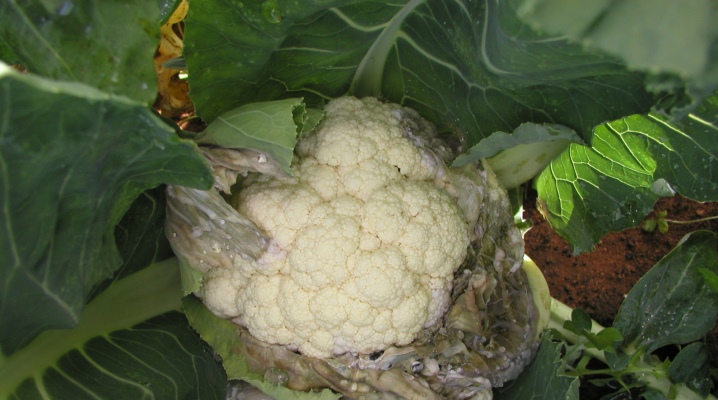
Cauliflower is a healthy vegetable that occupies a worthy place in the diet and is recommended in the diet. The culture was bred in the 17th century by crossing two varieties: collard and white cabbage. It is an annual plant, which is a bunch of edible inflorescences. There are three varieties of cauliflower - early with a ripening period of 90 days, medium - up to 110 days, and late.
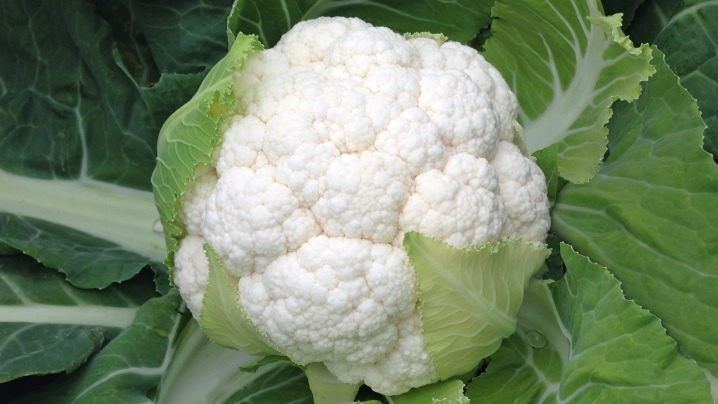
Treatment of diseases
Growing cauliflower outdoors requires experience and knowledge. Not every amateur gardener can get a solid harvest. With the advent of hybrid varieties that can withstand difficult weather conditions, it has become easier to care for the crop. However, soil freezing is still dangerous, and the cabbage head does not tolerate a drop in temperature well.
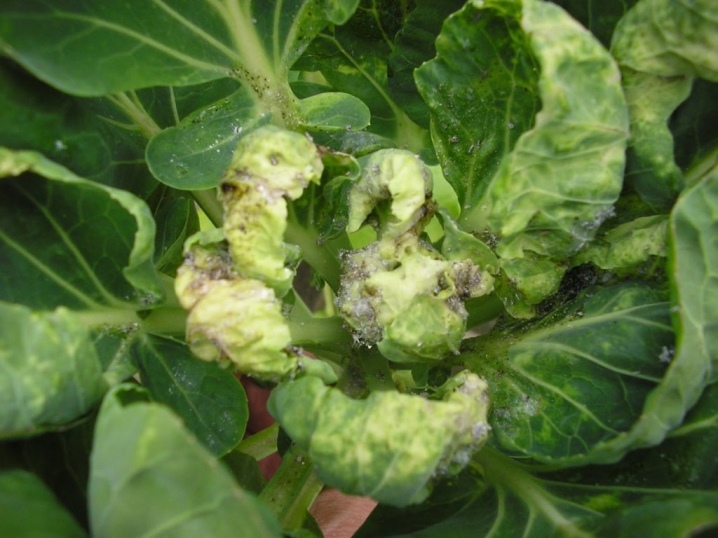
Excess moisture, changes in soil acidity and cold can cause the appearance of fungi and viruses. The weakened plant is attacked by diseases and parasites.
-
Blackleg. The scientific name is rhizoctoniasis. Black leg infection is dangerous for seedlings, seedlings at the beginning of growth. The stalk of the cabbage turns black, dries up, which leads to the destruction of the young plant. Densely planted seedlings can infect nearby vegetables, jeopardizing eggplants, radishes, tomatoes, and other crops. To combat, potassium permanganate is used, in which the seeds are soaked before planting. The area is additionally sprayed with a fungicide.
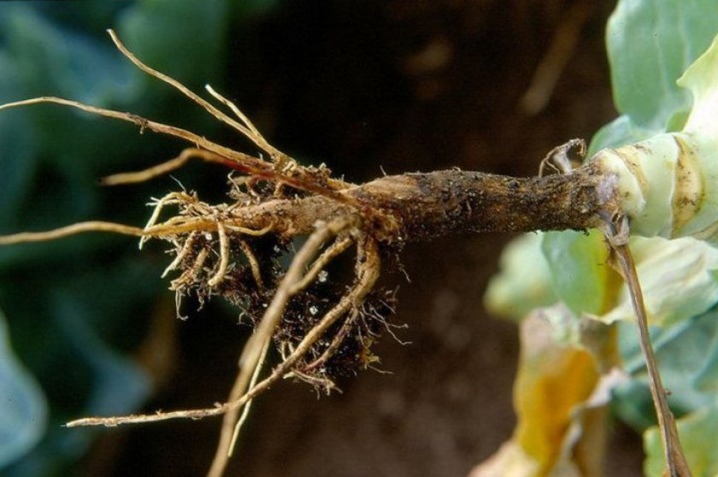
-
Gray rot. Places of rotting of a dirty gray color appear on the heads. Ripe vegetables rot, the entire harvested crop may die. To prevent the spread of infection on the head of cabbage, the affected part is cut off. A solution of lime helps from the fungus.
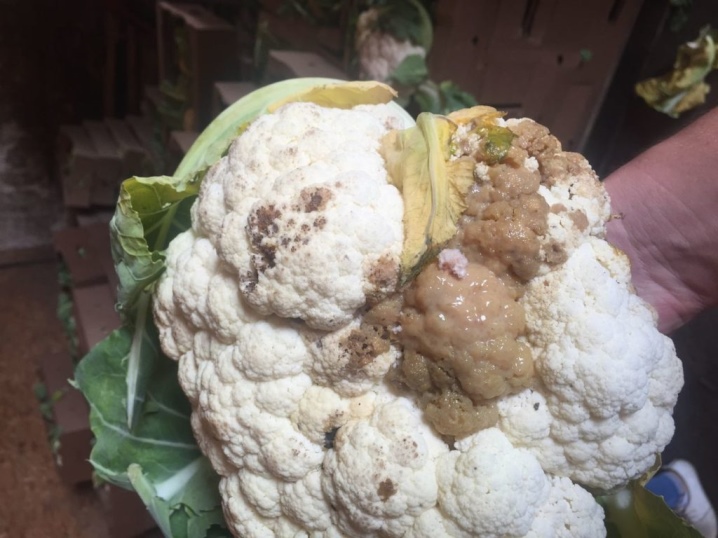
-
White rot. It manifests itself after harvesting. Cabbage heads do not withstand storage, they show a terry bloom with black dots inside. Rotting spreads quickly, spreading to neighboring vegetables. The fungus thrives in high humidity combined with low air temperatures. Heads of cabbage weakened by damage are especially susceptible to infection. Therefore, it is recommended to remove the crop from the beds before the onset of the first frost. Watering the cabbage is stopped 20 days before harvesting so that the moisture can be absorbed. The storage is disinfected, the heads of cabbage are carefully sorted.
-
Downy mildew or downy mildew. Leaves and stems are affected, on which dark spots and whitish bloom appear. The disease prevents cabbage from growing. If the inflorescences are not affected, they can be eaten later. To avoid contamination, the seed is soaked in hot water for half an hour, and then kept in cold water for several minutes. After the harvest is harvested, the beds are cleared of weeds.
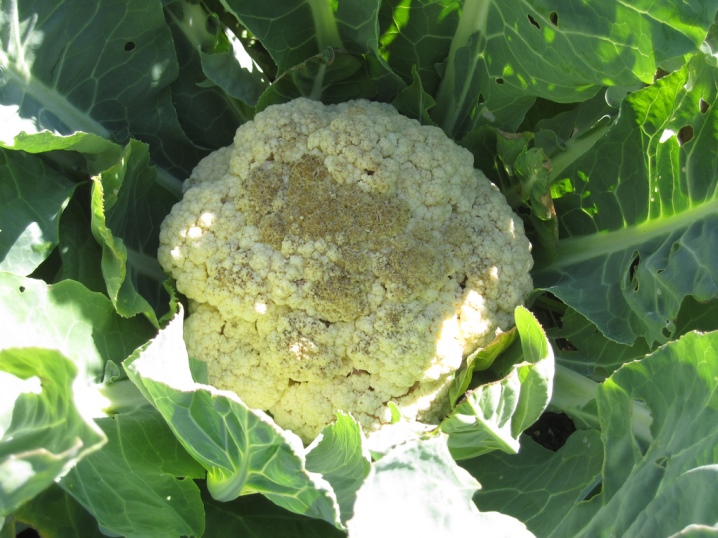
-
Mucous bacteriosis. Infection with bacteria that spread by insects. The causative agents of mucous bacteriosis love warm and dry weather. As a result of exposure to pathogenic flora, inflorescences become brown, stems and leaves rot and get wet, exuding a stench. In the early stages of infection, it is recommended to remove entire bushes. The formed heads can be tried to be cleaned of rot, they cannot be stored after that. The site is treated with biofungicides.
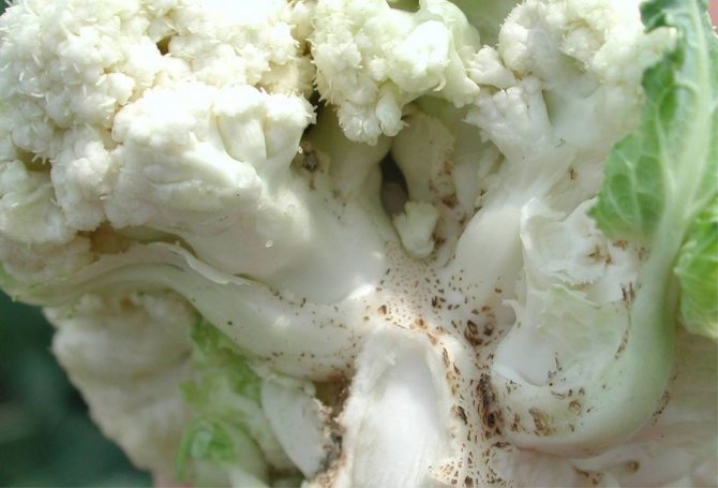
-
Fusarium wilting. A fungus that infects spores inside the soil. Appears in extreme heat and dryness. Spores live up to 10 years, so it is almost impossible to save the plant. The infection manifests itself as dark brown dots on the head of the cabbage.The stem and leaves turn yellow and wither. Sick vegetables must be removed and destroyed, and the soil must be treated with copper sulfate.
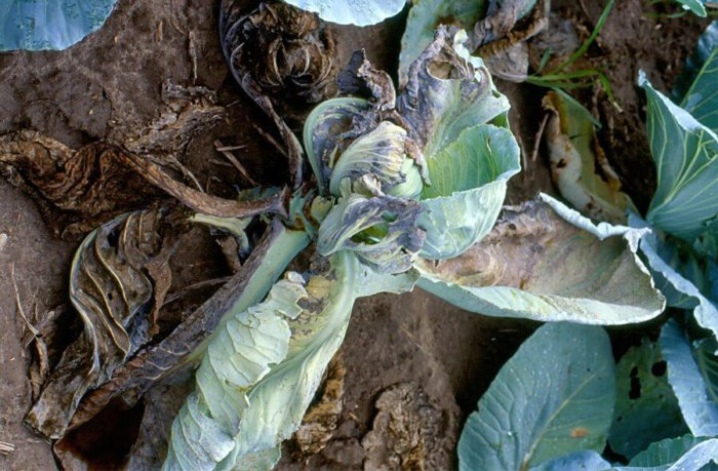
-
Mosaic. The virus infects all cruciferous plants, very often cabbage. Sowing material and sprouts become infected with aphids, which carry this dangerous pathogen. The symptoms of the disease become visible a few weeks after planting. The head is poorly formed and turns yellow, the leaves dry and die off, the fragile plant withers. Infected plants cannot be saved by known means; they must be dug up and destroyed.
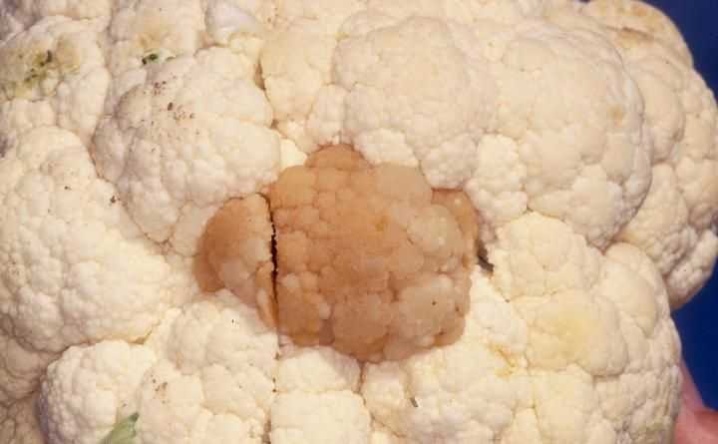
-
Keela. One of the harmful infections that has been living in the earth for years. The fungus can infect seedlings and persist in them. The disease attacks the roots, preventing the cauliflower from developing. The foliage looks lethargic, recovering by night, then wilting intensifies, despite all the measures taken. The heads are not formed, but growths are formed on the roots. They fight the keel using colloidal sulfur and foliar feeding with the addition of trace elements.
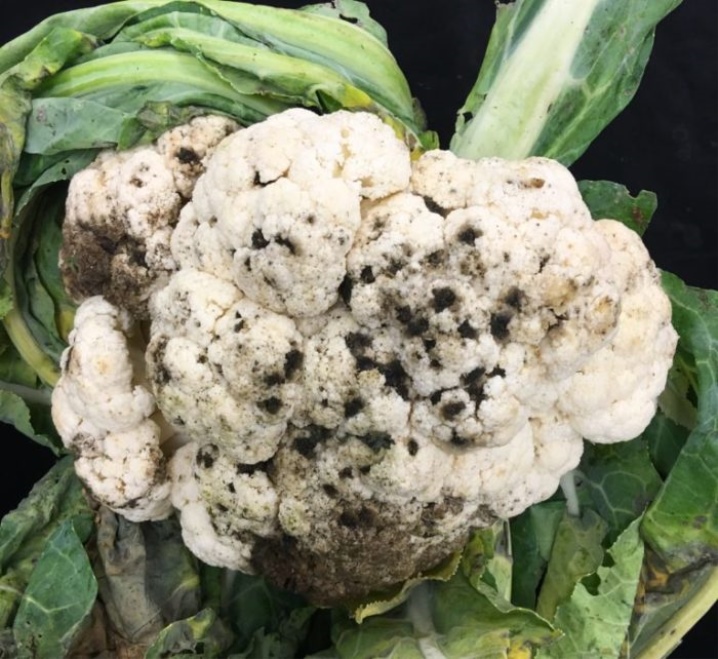
- Vascular bacteriosis. A common disease that affects the vascular system of a plant. Like other bacteria, it leads to leaf damage with yellow dots along the edge of the leaves. It manifests itself at all stages of maturation. Gradually, the blackened leaves and stems fall off, and the plant dies. There are no effective methods for getting rid of the disease. Experts recommend observing breaks in planting - at least 3 years, deeply cleaning the soil. And also take measures to destroy cabbage flies and slugs that move around the area with raindrops and spread the virus. After removing the infected vegetables, the garden is watered with a solution of colloidal sulfur.
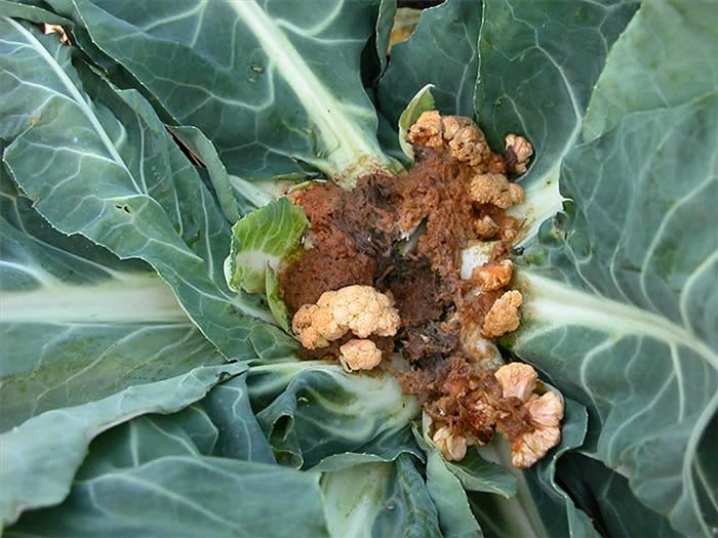
Pest control
Cauliflower needs healthy soil with optimal acidity. Watering with tap water and digging alters the structure of the soil and disrupts the layers. As a result, pests appear in an unhealthy environment, and effective protection with chemical and folk remedies is needed.
A complete description of pests includes more than 25 species. Some of them are in the soil and infect the roots. The second group affects stems and leaves - these are terrestrial pathogens. Cabbage is most often attacked by cruciferous fleas, butterflies, aphids and cabbage fly, bear and slug.

Aphids crawl between inflorescences and suck juices from early cabbage varieties. Large colonies of parasites are not easy to eradicate. In one summer, two dozen generations of aphids are hatched. As a result of the harmful effects of the plant, a sticky plaque envelopes, they change color and die. You can get rid of the parasite with folk remedies: boil 300 g of ash in 10 liters of water, add 50 g of laundry soap. Treat the cauliflower with this solution.
And also put 250 g of makhorka in a bucket of water, insist with the addition of hot pepper and soap. Tobacco is planted between the rows.
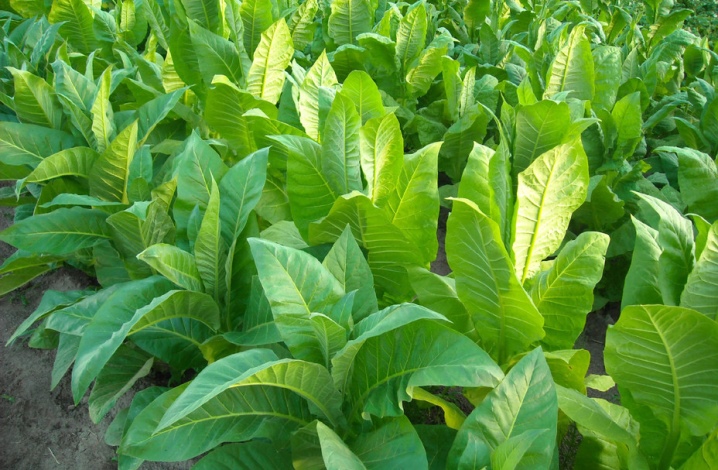
The cabbage fly starts flying with the first warmth when the cherry blossoms. Eggs appear on the roots, on the ground, and the larvae gnaw and spoil the root system. The sprout gradually withers and withers. To prevent this, the seedlings are sprinkled with ash and tobacco dust. Protect the root system by treating with a solution of iodine and ammonia. To prevent the fly from laying eggs, a circle of paper is put on the stem.
Butterflies, such as white and moth, scoop, lay their eggs on the bottom of the leaves. The caterpillar eats leaves, makes moves in the head, affects the inflorescences. A tincture of bitter ash with boiling water and soap helps well against caterpillars. Spraying is carried out often, every other day.

Belyanka is driven off by a solution in which 10 liters of water are mixed with two tablespoons of salt, the same amount of mustard, and one spoonful of soap. Add a spoonful of black hot pepper to the composition.
Cruciferous fleas are small black bugs that gnaw holes in young foliage. The appearance of fleas can destroy all crops.To combat them, use a solution with soap and ash, shampoo for dogs (at the rate of two caps per bucket of water). Table vinegar is suitable as a remedy - a solution consisting of a bucket of water and half a bottle of 9% vinegar. Spraying is considered an effective way to deal with a flea, as it allows you to reach any place on the bush.
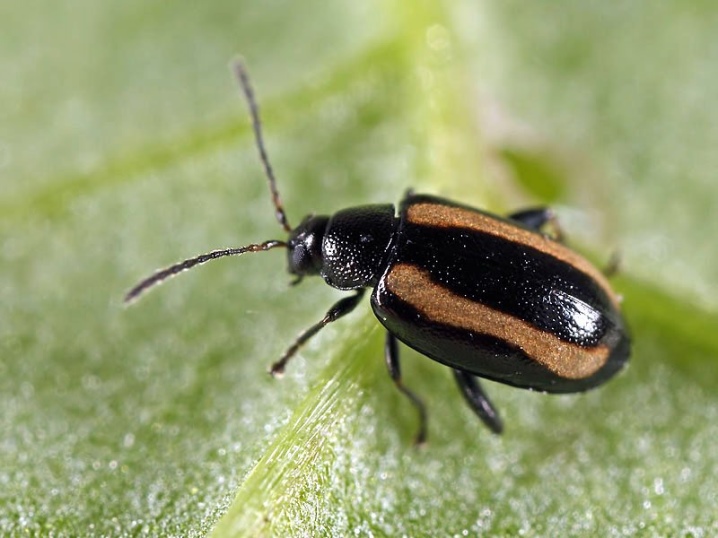
Water can also be mixed with fir essential oil, adding enough oil to give off a pungent odor, and spray the bushes.
Prevention measures
Experts believe that preventive measures are more effective than subsequent fight against infections. Moreover, many of the diseases cannot be cured. To protect the plant, to protect it from the effects of pests, you must strictly follow the recommendations. First of all, it is important to check the cleanliness of the site. The contaminated soil is determined by its characteristic features:
-
the earth loses its natural appearance, dryness is increased, the color of the soil is abnormal, the surface looks "lifeless";
-
the smell of rot from the decomposition of the inner layers is often felt;
-
planting in infected soil quickly leads to a reaction of the seedlings - on the 2-3rd day the root system disappears, the leaves turn yellow and wither.
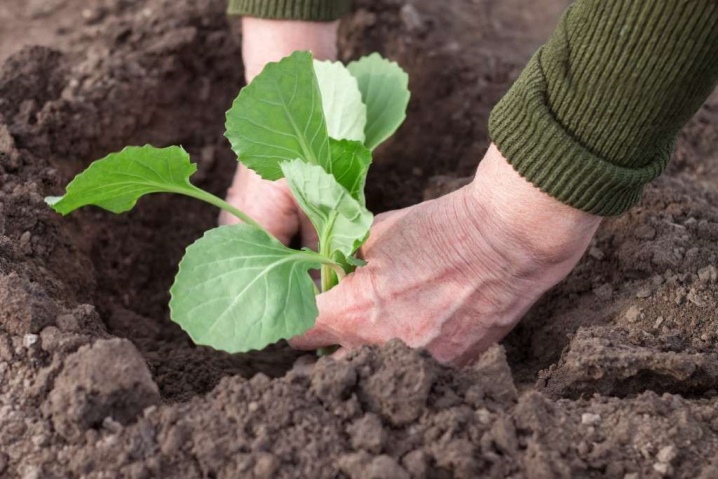
If changes are noticeable on the leaves or head of cabbage, you should not immediately think about the plant disease. Perhaps the culture needs additional nutrition with useful substances, it lacks trace elements. The external environment can also adversely affect the appearance. For example, the heads become pinkish when exposed to sunlight. To prevent this from happening, the leaves are tied, protecting the inflorescences.
The appearance of the plant signals the lack of various minerals.
-
Magnesium sulfate. The leaf plates are discolored, which is a sign of magnesium deficiency. The soil urgently needs to be fertilized with magnesium.
-
Phosphorus. Yellowed leaves that curl around the edges are the first sign of a lack of phosphorus in the soil. The introduction of superphosphate is shown.
-
Nitrogen. The leaf plates turn red or take on a purple hue. Treatment is ammonium nitrate. Experts recommend fertilizing before the final growing season to prevent disease.
-
Potassium sulfate. Dark dots appear along the edges of the leaf, then the foliage expects necrosis and death. The dangers can be avoided by feeding the roots with potassium in time.
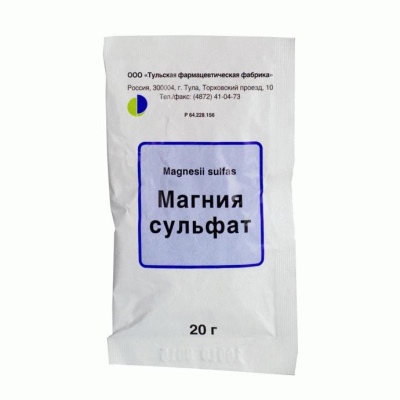
Cauliflower is a delicate crop that requires maintenance, and only attentive gardeners can harvest a good harvest. Agronomists strongly recommend not to go beyond the rules of crop rotation, not to plant cabbage all the time in one place in the garden. It is also necessary to feed the soil on time, preventing the soil from excessively oxidizing.
Seeds and soil should be checked and decontaminated before planting. Water the cabbage as scheduled to avoid excess moisture or dryness. There should be no place for pests and insects in the garden, they should be mercilessly fought with.
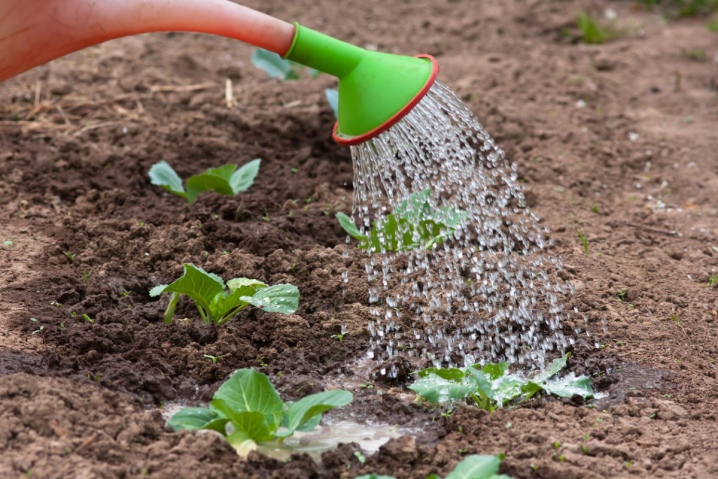
After harvesting vegetables, the remaining vegetation must be removed and disposed of. With careful adherence, such preventive measures will help preserve the harvest.
At first glance, it may seem that insecticides will help get rid of pests faster. In order to expel all the parasites, you will have to apply several different insecticides. It is difficult to foresee what will happen to such a plant, whether it will be suitable for food. Allergies and poisoning from processed vegetables are not uncommon. For this reason, folk remedies remain a priority for experienced gardeners.
How to treat cauliflower from pests, see the next video.













The comment was sent successfully.